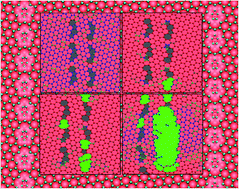Strength and failure behavior of a graphene sheet containing bi-grain-boundaries†
Abstract
By using molecular dynamics simulations, the mechanical properties and failure mechanisms of a graphene sheet containing bi-grain-boundaries were examined. The results reveal that both temperature and density of defects play central roles in the mechanical characteristics of graphene containing bi-grain-boundaries. By increasing the temperature, the tensile strength and fracture strain significantly decrease. The graphene containing high density defects is much stronger than that containing lower density defects. The dependence of Young's modulus on temperature is also investigated. The results also show that the failure processes of graphene sheets containing bi-grain-boundaries are dominated by brittle cracking.


 Please wait while we load your content...
Please wait while we load your content...